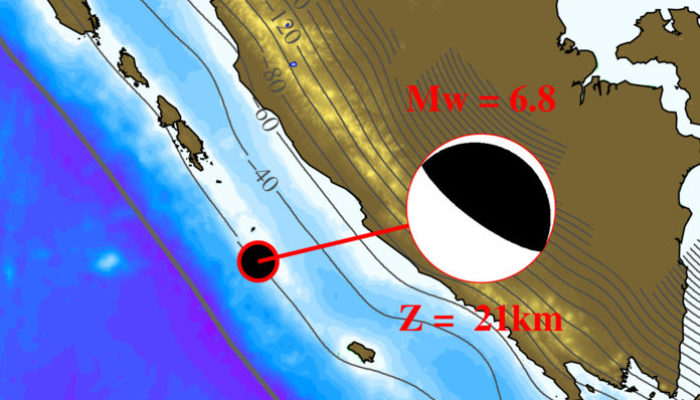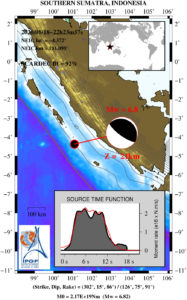
August was not highlighted by a large event (> M7) and the choice for the earthquake of the month was a bit tricky. Four events were available to choose from: An intraplate EQ in the US (M5.1), the largest event in this region since 1916, an M6.6 in the Philippines, a deep earthquake (~620 km) M6.9 in Indonesia, and a doublet earthquake (M6.8 – 6.9) in Indonesia. After some discussion, we made our choice.
On August 18th, Indonesia was hit by two shallow events (< 30 km depth) with M6.8 and M 6.9, less than 10 min apart and in the same location (Fig. 1). This quick consecutive occurrence of events is what we generally call doublet or multiplet earthquakes. In this case, they developed in the Sunda Trench (6 cm/yr convergent rate) where the Australian and Sunda plate collide. The southern part of the trench generated in 2007 the M8.4 earthquake (Fig. 2). This region knew several tsunamigenic earthquakes (Natawidjaja et al. 2006), fortunately, in August no tsunami alert was triggered and no damage reported in this region.

Historical great earthquakes of the obliquely convergent Sumatran plate boundary (Chlieh et al., 2007). Red dot corresponds to the location of 2020 Bengkulu doublet, the blue star the 2007 M8.4 Bengkulu event with the segment broken in dark green.
The focal mechanisms and hypocenters are comparable with subduction earthquakes. A preliminary analysis of slip distribution suggests a maximum slip between 60-70 cm (Fig. 3). Several weeks after these two events, no information about surface deformation from SAR or GPS analysis have been made available.
The doublet earthquakes show a strong similarity (Fig. 4), their hypocenters are in close proximity and they can occur from a few seconds to several years between them. For example, the doublet Landers and Big Bear earthquake in 1992 had a three-hour delay between them. The largest great doublets (M8.3 and M 8.1) occurred in 2006 and 2007 along the Kuril arc (Ammon et al., 2008; Lay et al. 2009). If in the case of the Bengkulu these events were shallow, but doublet earthquakes can also occur as the deep Peru events in 2015 (Ruiz et al., 2017) at 600 km depth. In the seismic cycle of the subduction zone, doublet earthquakes play a key role (Ammon et al. 2008) and reflect fluid migration (Mastromembo et al. 2016).

Recording of the Bengkulu doublet from a Raspberry shake (RD10DB) located in Vienna (Courtesy: Eric Löberich, member of the ECS representative team)
TOP 3 – August earthquakes
Bengkulu doublet (Indonesia) – 18th August – M6.9
Katabu deep earthquake (Indonesia) – 21st August – M6.9
Masbate earthquake (Philippines) – 18th August – M6.6
References
This blog post was written by ECS representatives Javier Ojeda and Walid Ben Mansour
with revisions from ECS representative Maria Tsekhmistrenko


